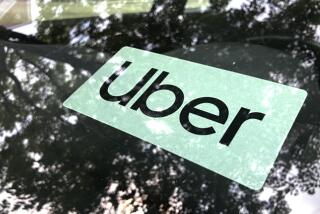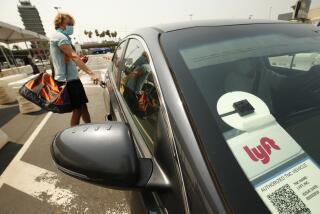Hail to the Cabbies: Global Adventures in Sitting : CABBIES: Adventures
- Share via
Here’s the story line of an upcoming movie called “Graveyard Shift”: “When a 350-year-old vampire drives a cab on the night shift in New York City, terror is his favorite passenger . . . and the meter is running.” Sound familiar?
To be sure, New York City’s cabbies always have had a dubious reputation. It’s been said that you don’t simply ride in a taxi in the Big Apple . . . you attempt to survive in one.
That’s not really fair, actually. Considering traffic and the general condition of the roadways (after all, a trip up potholed Madison Avenue is often more grueling than the Baja 500), the New York taxi drivers do a reasonably good job.
New York has 11,787 yellow Medallion cabs, with 41,000 licensed drivers. And last year only 15 drivers had their licenses revoked because of passenger complaints.
Don’t Speak English
There are problems, of course. A new generation of non-English-speaking taxi drivers has made it more difficult to get around the city. Another problem in New York--added to a recent 22% fare increase--is driver attitude.
Recently, the New York Taxi and Limousine Commission conducted a sting operation called “Easy Rider.” A total of 35 inspectors, most of whom were black or Puerto Rican, hailed cabs and asked to be taken to “popular refusal points”--the South Bronx, Harlem or Bedford Stuyvesant in Brooklyn. All told, 14% of the drivers refused.
Still, I’d rather take my chances with a cab ride in New York than a lot of other places.
In New Delhi, for instance, finding a cab is often impossible. You can’t hail one on the street, taxi stands are difficult to find and, if you should be lucky enough to find one, remember that cabs in New Delhi have a nasty tendency to break down.
In Lagos, Nigeria, you don’t hail a cab, you beg for one. And then you argue over the fare.
Negotiate Your Fare
In Mexico City, negotiate your fare before you get into the cab. Few taxis have meters, and those that do don’t work.
The same is true in Thailand, where taxis have meters that are nothing more than ornamental. One general rule in negotiating your fare: Whatever the driver asks, divide by three and settle at one-third the asking price.
In Bangkok at least the non-working meters benefit passengers: The traffic is frequently voted the worst in the world, and long waits on city streets are normal.
Sometimes the meters in Asian taxis can work in your favor. In Manila the taxi meters start at 12 cents U.S., and the fare inches upward at glacier-like speed.
You find “Indiana Jones Autograph Model” taxis in Cairo. Imagine a car that has been repeatedly crashed into a wall. Other than the engine, only the horn works. You are now in an Egyptian taxi. There are, however, two compensations to taking a taxi in Cairo.
First, you don’t have to take the bus, meaning you inhale less fumes and dust. And the second is--assuming you negotiate the cab fare before you get into the taxi--the drivers are quite friendly.
Often, cities only solve their taxi problems when faced with major national or international events.
Cabs Cleaned Up
In Australia, Perth worked hard to clean up its cabs in time for the America’s Cup races. And Brisbane, home of next year’s Expo ‘88, has 1,425 taxis divided between only two companies. The taxi council of Queensland is hard at work inspecting the taxis and starting a drivers’ educational program to help them learn more about their city.
Atlanta, host to next summer’s Democratic National Convention, is facing a similar problem. Many of the city’s taxis are driven by newcomers to Atlanta who don’t know their way around the city.
In Korea, cabs are cheap--if you speak Korean. Otherwise, unless you are carrying a Korean map of where you need to go, prepare to get hopelessly lost.
Most taxis and taxi drivers in Seoul are getting ready for next year’s Summer Olympics. Drivers are being given crash courses in English, and the government says it will severely restrict licenses to any taxi driver who is not basically fluent in English by next September.
The one city that has no excuses for a bad taxi system is Washington, D.C.
Nothing can be more confusing than cabs and cab fares in the nation’s capital. It’s been said that almost a third of the city’s 11,000 drivers have no license or valid insurance, and often have no idea where they are going.
Bad Driving Records
Other drivers have notoriously bad driving records. Recently I was a passenger in a Washington cab that suddenly lurched to the left and smashed into a large delivery truck. It soon became obvious that this was not my driver’s first brush with another vehicle.
He nonchalantly shook his head, reached into his glove compartment and pulled out a camera he keeps with him to record such events.
The zone fare system in Washington is confusing. So is the cab situation in Kansas City. At the airport I counted 18 cab companies, and fares ranged from $20 to $28 to go to the city’s Crown Center.
Sometimes, when you analyze what it really costs to take a cab in major U.S. cities, it’s often cheaper to rent a car, or in some cases, fly a plane.
Los Angeles Loses
A recent survey by the New York City Taxi and Limousine Commission, which studied how far $5 would take you in each of 11 cities, found passengers could go 5.1 miles in Baltimore (the winner) and only 2.2 miles in Los Angeles, the loser.
In Houston it’s cheaper to fly from Hobby Airport to the city’s Intercontinental Airport--only $15--than to take a cross-town cab.
In terms of pure politeness of drivers and taxi neatness, taxis in London and Tokyo still get kudos. There are more than 13,000 of them in London. They are large, comfortable and frequently inspected. Prospective cab drivers have to pass a battery of special exams, memorizing 480 cab runs within a six-mile radius of Charing Cross station. The tests aren’t easy--for example, there are 31 Albert Roads in Greater London.
In Tokyo, taxi seats are covered in white linen. Doors open automatically. Some cabs even feature TV and coin-operated massage. Most cabs are radio-equipped, so if a driver gets lost (and in Tokyo, where most streets are not named, that happens quite often), he can ask instructions.
No Tipping in Tokyo
And there’s no tipping the drivers in Tokyo. This isn’t a Japanese custom. Usually, it seems, foreign visitors paying their cab fares with a little extra money intended as a tip find themselves followed by the drivers, who insist on giving them their change.
But Tokyo cabs are very expensive--nothing short of meter madness. Travelers with lots of extra money won’t mind the cab ride from Narita Airport to downtown. It’s a one-hour ride that often costs as much as 25,000 yen ($175 U.S.).
Once in the city, the cabs remain just as costly--it’s 470 yen just to start the meter. Even the Japanese National Tourist Organization warns about the cabs. In a recent publication, the JNTO said that “taxis are only for the well-to-do.” But they are efficient.
Cab efficiency also ranks high in much of Europe. Taxis in Frankfurt and Bonn are known for their reliability. In Rome, taxi passengers sometimes think they’ve been entered in a road rally. In Italy (assuming no one is on strike, which is assuming a lot), speed is of the essence. So sit back . . . and hold on.
Polite Taxi Drivers
Stockholm also boasts some of the most polite cabbies I’ve ever seen. While I was waiting outside Stockholm’s central railway station, each driver who pulled up for a fare would stop the vehicle, get out and open the door for his passenger.
One caution: Swedish cabs can be expensive. A trip to Arlanda Airport, for example, can cost more than $60.
But if you really want to spend money on a cab ride, fly to Zurich. After your Swiss cab excursion, you may discover that the air fare getting there was cheaper.
Zurich is the undisputed leader for costliest taxis. While a three-mile taxi ride in Tokyo will cost you a whopping $7.50, the same ride in Zurich will be about $15.
Some cities have streamlined their cab dispatch systems to make it easier--and faster--for passengers to be picked up.
Computerized Cabs
In Canada, cabs are computerized in Ottawa and Vancouver. Yellow Cab in Indianapolis now has a $750,000 main computer with terminals for each taxi. And in Stockholm, cab drivers punch in their location to a central computer. When a call comes in for a cab, a computer in the nearest cab prints out the call. If it isn’t acknowledged by the driver in 30 seconds, it goes to the next nearest cab.
And what if there are no cabs to be found? One hotel in downtown Montreal is offering a partial solution. The Shangrila has imported 12 three-wheeled trishaws from Singapore. The vehicles (powered by very fit college students) will be made available to guests who either can’t wait for a taxi or want to travel in style.
More to Read
Sign up for The Wild
We’ll help you find the best places to hike, bike and run, as well as the perfect silent spots for meditation and yoga.
You may occasionally receive promotional content from the Los Angeles Times.






